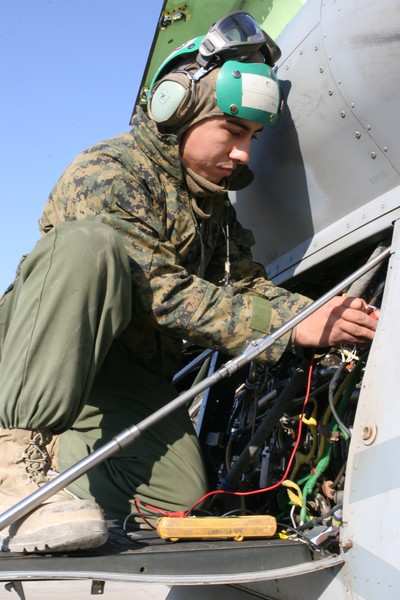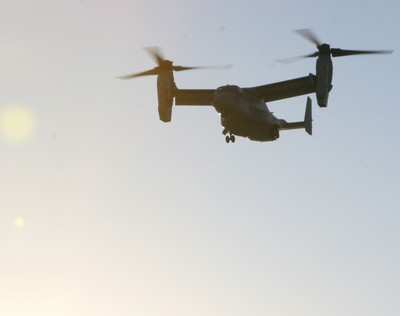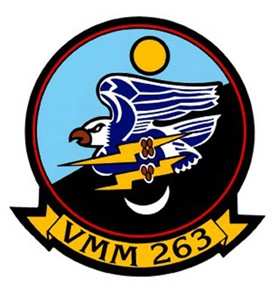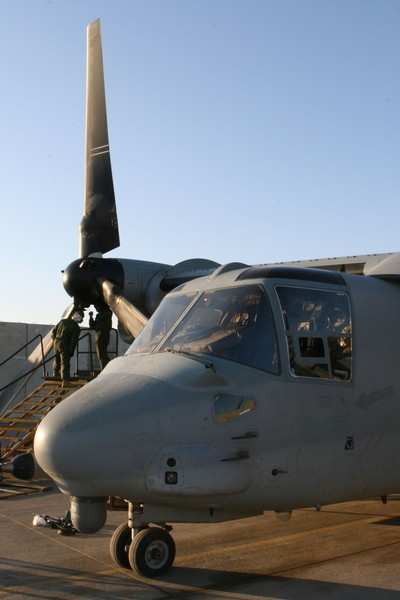Tiltrotors Achieve 68.1 Percent Reliability Rate In
'Sandbox'
Marine Medium Tiltrotor Squadron 263 arrived at Al Asad, Iraq on
October 4, 2007 to support air operations in the Al Anbar
province... and so far, according to USMC officials, the squadron
and its MV-22 Osprey tiltrotors have performed admirably.

The 'Thunder Chickens' took over the entire range of combat
medium lift assault support missions in support of Multi-National
Forces -- West from Marine Heavy Helicopter Squadron 363 to include
battlefield circulation, raid and Aeroscout operations,
helicopter/tiltrotor governance, Tactical Recovery of Aircraft and
Personnel alert and casualty evacuation alert, flying everywhere
within MNF-West throughout the battlefield from Baghdad to Al Qaim
providing an operational capability over distance and time that has
effectively collapsed the battlespace.

The squadron has completed more than 2,000 ASRs in the first 3
months of the deployment, keeping approximately 8,000 personnel off
dangerous roadways and accruing approximately 2,000 flight hours.
The squadron notes it has accomplished every mission, and met every
schedule, while maintaining an average mission capable availability
rate of 68.1%. (That's on the low side for a commercial
aircraft... but impressive for a new military-spec aircraft in a
combat zone -- Ed.)
Officials note the New River based MV-22 squadron has
experienced a higher operational tempo while deployed, with the
squadron completing missions and accumulating flight hours at a
sustained rate well in excess of anything they've done before.
"The area of operations has, in a number of ways, highlighted
the performance of the aircraft," said Lt. Col. Paul Rock,
VMM-263's commanding officer. "Our area of operations is large and
the aircraft's speed and range has been much-appreciated by many of
the folks the squadron has supported. In addition, the precision
navigation and situational awareness systems in the aircraft have
enhanced our ability to perform such tasks as desert landings in
brownout conditions."

In brownout conditions, the MV-22's unique hover coupled
capability significantly increases the safety of troops in the
execution of combat missions enabling the Ground Combat Element to
be safely and precisely inserted on the desired combat coordinates.
No other helicopter or aircraft in the inventory has this unique
operational capability and safety enhancement. It reduces and
mitigates risk while significantly increasing both Ground Combat
Element and aircraft survivability.
Cpl. Bob Cowan, a crew chief with VMM-263, believes the aircraft
has performed better than expected. The normal wear and tear of the
desert hasn't been as harsh on the bird as was originally
expected.
"The aircraft has performed better than expected," said Cpl.
Daniel Stratman, a '263 crew chief. "We haven't had to replace any
major parts like prop boxes or anything; the main problem out here
is getting the parts for this aircraft. We can fix just about
anything, the only thing that slows us down is getting the
parts."
 As a new aircraft, the
supporting logistics system is new and this deployment provides
valuable maintenance and logistics lessons learned that will
enhance support of the aircraft in the future.
As a new aircraft, the
supporting logistics system is new and this deployment provides
valuable maintenance and logistics lessons learned that will
enhance support of the aircraft in the future.
The squadron, which was the Marine Corps' first Tiltrotor
squadron, has been training for this deployment since they stood up
in March of 2006. Aside from the normal pre-deployment and Desert
Talon training, the unit has completed two deployment-for-training
operations to practice landings in brown out conditions and they
also completed training with infantry Marines practicing inserting
troops during raids and other ground operations.
"We had some snags at the beginning, but we've learned from our
mistakes," said Cowan, a Cookeville, TN native. "We've done the
training back in the rear, but performing the missions out here is
different, so we've ironed out the wrinkles."
The Marines of the squadron have kept their heads held high
throughout the deployment and have done well at keeping the
'Osprey' mission ready.
"Our Marines are doing great; it's incredible to watch them
work," said Sgt. Maj. Robert VanOostrom, the unit's sergeant major.
"The weather is getting worse everyday ... but they have to ensure
a certain amount of aircraft are prepared to fly every day. The
amount of time and energy they put in every day to make sure the
aircraft fly, is incredible."
Almost every service member has heard of the new aircraft, but
most Marines haven't even seen the aircraft fly, not to mention fly
in it. Now, many service members are getting their first flight in
the Corps' faster, farther traveling and heavier lifting
aircraft.
"In North Carolina you see the 'Osprey' flying every single day
and it's just another aviation platform. ," said VanOostrom. "It's
ironic to see the individual Marine who gets on the airplane for
the first time and sees what it can do and says 'This is the
coolest thing I've ever seen.'"

The 'Thunder Chickens' have transitioned from a trained squadron
to an experienced combat squadron that has completed every tasking
and succeeded in maintaining the deployed operations tempo. VMM-263
has flown 5 Aeroscout missions, 1 raid, more than 1400 combat
sorties and maintained an average mission capable readiness rate of
68.1% during their current deployment to Operation Iraqi Freedom
06-08.
(Aero-News salutes II MAW (FWD) PAO, 2nd Marine Aircraft
Wing (FWD)
 Airborne 10.20.25: FAA Eases On Boeing, Flexjet Lawsuit, Textron Chops eAviation
Airborne 10.20.25: FAA Eases On Boeing, Flexjet Lawsuit, Textron Chops eAviation Airborne-NextGen 10.16.25: Cops Shooting Drones?, Lilium Patents, Trains v UAVs
Airborne-NextGen 10.16.25: Cops Shooting Drones?, Lilium Patents, Trains v UAVs Airborne 10.17.25: Gryder Airport/Gun Arrest, Hegseth C32 Probs, Hartzell Update
Airborne 10.17.25: Gryder Airport/Gun Arrest, Hegseth C32 Probs, Hartzell Update Classic Aero-TV: ICAS Perspectives - Advice for New Air Show Performers
Classic Aero-TV: ICAS Perspectives - Advice for New Air Show Performers Airborne-NextGen 10.21.25: NZ Goes Electric, World Cup UAVs, eAviation Shuttered
Airborne-NextGen 10.21.25: NZ Goes Electric, World Cup UAVs, eAviation Shuttered







